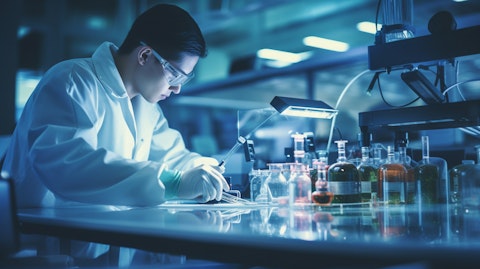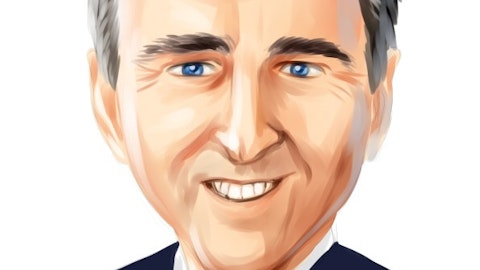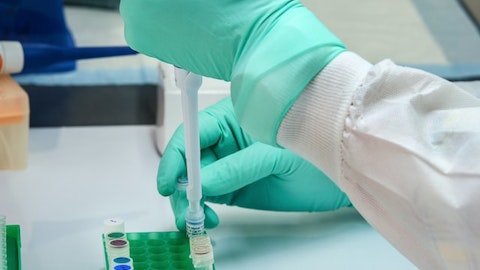Clearside Biomedical, Inc. (NASDAQ:CLSD) Q3 2023 Earnings Call Transcript November 13, 2023
Clearside Biomedical, Inc. beats earnings expectations. Reported EPS is $-0.15, expectations were $-0.16.
Operator: Greetings, and welcome to the Clearside Biomedical Third Quarter 2023 Financial Results and Corporate Update Call. At this time, all participants are in a listen-only mode and a question-and-answer session will follow the formal presentation. [Operator Instructions] Please note, this conference is being recorded. I will now turn the conference over to your host, Jenny Kobin of Clearside Investor Relations. Ma’am, the floor is yours.
Jenny Kobin: Good afternoon, everyone, and thank you for joining us on the call today. Before we begin, I would like to remind you that during today’s call, we will be making certain forward-looking statements. Various remarks that we make during this call about the Company’s future expectations, plans and prospects constitute forward-looking statements for purposes of the Private Securities Litigation Reform Act of 1995. Actual results may differ materially from those indicated by these forward-looking statements as a result of various important factors, including those discussed in the Risk Factors section of our annual report on Form 10-K for the year ended December 31, 2022, our quarterly report on Form 10-Q for the quarter ended September 30, 2023 to be filed today, and our other SEC filings available on our website.
In addition, any forward-looking statements represent our views as of today and should not be relied upon as representing our views as of any subsequent date. While we may elect to update these forward-looking statements in the future, we specifically disclaim any obligation to do so even if our views change. On today’s call, we have George Lasezkay, our Chief Executive Officer; and Charlie Deignan, our Chief Financial Officer. After our formal remarks, we will open the call for your questions. I would now like to turn the call over to George.
George Lasezkay: Thanks, Jenny, and good afternoon, everyone. Today, I’m excited to discuss several recent value creating achievements related to our suprachoroidal platform. We’ve had two weeks of really good news. We completed enrollment in ODYSSEY, our Phase 2b wet AMD clinical trial, with top line data expected in the third quarter of 2024. We announced a new partnership with BioCryst Pharmaceuticals to expand our external development pipeline with a plasma kallikrein inhibitor for the treatment of diabetic macular edema. Both of our other suprachoroidal collaboration partners, REGENXBIO and Aura Biosciences, recently presented positive safety and efficacy data through Phase 2 with their respective compounds using our SCS microinjector.
As for our XIPERE partners, Bausch & Lomb announced that XIPERE has been granted a permanent Category 1 CPT code in the U.S. to help facilitate better access and adoption of the product. And Arctic Vision completed enrollment in their Phase 3 clinical trials Arcadis, also known as XIPERE, in uveitic macular edema in China. So let me start with discussing our lead program, CLS-AX. Last month, we completed recruitment in our ODYSSEY Phase 2b clinical trial evaluating the safety and efficacy of CLS-AX, our highly potent tyrosine kinase inhibitor delivered by our patented SCS microinjector. As a reminder, ODYSSEY is a randomized, double masked, active controlled, multicenter study in participants with wet AMD. One of the most encouraging aspects of our CLS-AX program is the feedback that we receive from the medical community.
Multiple leading retinal physicians have presented data from our OASIS Phase 1/2a clinical trial of CLS-AX in wet AMD at top ophthalmic meetings, including the recent AAO, ASRS, and Retina Society meetings. These presentations highlighted the excellent safety profile, stable vision, and reduced frequency of injections observed for up to six months. These presentations also created significant interest in our program from clinical trial participants, investigators, and sites that help drive strong recruitment for our ODYSSEY Phase 2b trial. The completion of recruitment is a critical accomplishment for us as the final participants in the study advance to randomization, either to the CLS-AX treatment arm or the on-label aflibercept comparator arm.
We expect randomization to be completed by the middle of December 2023 and we remain on track to report top-line data from ODYSSEY in the third quarter of 2024. Our goals for the ODYSSEY trial are to demonstrate an excellent safety profile, stable visual acuity and a lower treatment burden in the CLS-AX arm. The efficacy and safety results from ODYSSEY will then guide our pivotal Phase 3 development program, or CLS-AX. We believe the differentiated mechanism of action and high potency of axitinib, combined with safe and reliable delivery into the suprachoroidal space, has the potential to be a best-in-class approach for long-term maintenance therapy for individuals with wet AMD. We were thrilled to start this month by announcing our new global licensing partnership with BioCryst Pharmaceuticals.
This collaboration expands the reach and demonstrates the versatility of our suprachoroidal injection platform by adding another compound to be delivered with our proprietary SCS microinjector. The agreement includes $5 million in an upfront license fee plus the potential for future milestone payments and sales royalties. The partnership with BioCryst is focused on the development of their proprietary small molecule, avoralstat to be administered via the suprachoroidal injection the treatment of diabetic macular edema. DME is the most common cause of vision loss in individuals with diabetes, and we believe there’s a significant market opportunity in this indication. Avoralstat has high potency and low solubility, which are characteristics that are well suited for suprachoroidal administration and important to achieving potential efficacy with reduced dosing frequency.

Delivering avoralstat into the suprachoroidal space and behind the visual field could allow avoralstat to inhibit plasma kallikrein directly at the location where the edema forms with a desirable durability of effect. BioCryst expects to continue conducting formulation and nonclinical work into 2024 and begin clinical trials in 2025. The versatility of our suprachoroidal injection form was on display at this month’s American Academy of Ophthalmology medical meeting, where two of our other partners, REGENXBIO and Aura Biosciences presented very promising data with their respective compounds utilizing our SCS microinjector. REGENXBIO reported the results of their Phase 2 ALTITUDE trial evaluating their gene therapy, ABBV-RGX-314 in diabetic retinopathy, the leading cause of vision loss in adults between 24 and 75 years of age worldwide.
314 continues to be well tolerated and 50 patients from dose levels 1 and 2 with no drug related serious adverse events. At the second dose level, 314 prevented disease progression and reduced vision threatening events in non-proliferative diabetic retinopathy at one year. REGENXBIO has indicated they believe that a one-time in office suprachoroidal injection of 314 gene therapy has the potential to stabilize and improve diabetic retinopathy severity score and reduce the long-term risk of vision threatening events. Aura Biosciences reported positive clinical efficacy updates from its ongoing Phase 2 clinical trial with suprachoroidal administration of Belsar for the first line treatment of early stage choroidal melanoma. Their Phase 2 trial is assessing the safety and preliminary efficacy of single and multiple ascending doses of Belsar for up to three cycles of treatment.
The Phase 2 data with 90% of their patients at 12 months of follow-up demonstrated 80% tumor control and 90% visual acuity preservation for patients that have been treated with three cycles of Belsar and that meet the Phase 3 enrollment criteria. Safety profile continues to be favorable with no significant or treatment related serious adverse events. This is very encouraging, as most of these patients had tumors close to the fovea or optic disc and would likely have experienced severe and irreversible vision loss with the current standard of care. Auras also announced agreement with the FDA under a special protocol assessment for the design and planned analysis of their Phase 3 COMPASS trial. We plan to dose the 1st patient in this trial this quarter.
In addition to the R&D progress over the last few months, our commercial partnership with XIPERE, have also announced important achievements. Bausch & Lomb announced that the American Medical Association has granted a new Current Procedural Terminology or CPT code for XIPERE with support from the American Academy of Ophthalmology and the American Society of Retina Specialists. Category 1 codes for the suprachoroidal injection procedure will help facilitate better access and adoption of XIPERE in the United States. The new CPT Category 1 code will be effective on January 1, 2024, replacing the current miscellaneous Category 3 code. At AAO, Bausch & Lomb also presented survey data on positive physician experience using XIPERE in the treatment of uveitic macular edema, indicating that physicians found XIPERE suprachoroidal injection easy to learn with patient outcomes consistent with clinical trial data.
Our Asia Pacific partner, Arctic Vision, also accomplished a major milestone with completion of enrollment in China of its Phase 3 randomized double blind placebo controlled clinical trial with XIPERE in uveitic macular edema. As a reminder, XIPERE is referred to as Arcadis in China. If positive, the data from the Phase 3 trial will allow Arctic Vision to apply for marketing approval in China. In addition, earlier this year, Arctic Vision applied for marketing approval of Arcadis in Australia. We appreciate the commitment of both Bausch & Lomb and Arctic Vision to expand the use of XIPERE and look forward to further updates. I’ll now turn over the call to our CFO, Charlie Deignan, to provide a financial update. Charlie?
Charlie Deignan: Thank you, George, and good afternoon, everyone. Our financial results for the third quarter were published earlier in our press release and are available on our website. Therefore, I will just provide a summary of our financial status. As of September 30, 2023, our cash and cash equivalents totaled approximately $29 million. Subsequent to the end of third quarter, we entered into the licensing agreement with BioCryst. We will receive $5 million in non-dilutive capital in the form of an upfront license fee. With this combined cash balance, we believe we have sufficient resources to fund our planned operations into the fourth quarter of 2024, which moves us past the expected completion of our ODYSSEY trial and the related top-line data announcement.
In terms of investor outreach, we look forward to participating in the Stifel Healthcare Conference on Wednesday of this week and BTIG’s 3rd Annual Ophthalmology Day later this month. We look forward to keeping the investment community updated on our progress. And I’ll now turn the call back over to George for his closing remarks.
George Lasezkay: Thanks, Charlie. The level of awareness and usage of suprachoroidal administration continues to grow with the progress from both our internal programs and our suprachoroidal development commercialization partners. When it comes to the adoption of new therapeutic treatments, we know that safety is the top priority for physicians and their patients. Our suprachoroidal approach is already a proven method of delivery with a very clean safety profile, both commercially and in clinical development. Including our new partnership with BioCryst, we now have five collaboration partners actively targeting the suprachoroidal space for treatment of multiple serious retinal diseases using our SCS microinjector. We believe this represents significant future value for Clearside and for our shareholders. I would now like to ask the operator to open up the call for questions.
See also Billionaire John Paulson’s Messy Divorce and Top Stock Picks and 16 Stocks Hedge Funds and Wall Street Analysts Are Crazy About.
Q&A Session
Follow Clearside Biomedical Inc.
Follow Clearside Biomedical Inc.
Operator: [Operator Instructions] Our first question is coming from Serge Belanger with Needham & Company. Your line is live.
Serge Belanger: I guess first one on the ODYSSEY trial. You completed enrollment, I think your target was 60 patients. Just curious, if you overshot that number and you’re assuming some level of attrition to get through a 36 trial, 36-week trial? And then secondly, maybe just talk about potential inflection points for the REGENX and Aura partnership?
George Lasezkay: Let me take the first one. We had a very healthy recruitment rate in ODYSSEY. We had 32 sites signed up, 30 sites recruited at least one subject. So, we had really good participation across all our sites. We’re very happy about that. We have our target, as you know, was 60 patients, a 2:1 randomization, 40 into the CLS-AX group and 20 in the on label aflibercept comparator group. And when we terminated our recruitment, we had exceeded that slightly. So, we’re a little over that goal. We may have some attrition as you normally do during the conduct of the clinical trial, but right now, we’re very happy with where we are. We’ve got more than 60 in the trial, and so we’re very grateful and very thankful to the sites and the KOLs and the investigators that participated. Like I said, it was a really, very, very robust screening and recruitment program, and we were glad for everybody’s participation. Your other questions were…
Serge Belanger: Regarding potential inflection points for the REGENXBIO and Aura partnership?
George Lasezkay: Well, the most important one is, I’ll start with Aura first is Aura is already got the FDA foregoing to Phase 3. I think the FDA looked at their Phase 2 data, felt very comfortable about that, and they’re looking to recruit their first patient. So the start of Phase 3 is going to be very meaningful to them as well as to us, and that should happen sometime this quarter. We’re very hopeful on that. And they are going to be not restricted to the United States. They’re going outside the United States as well to do their recruitment. For REGENX, the REGENX file comes in two stages. First, their DR from their ALTITUDE trial, and then they’ll have their wet AMD data, I think, early next year. But we were very, very happy with what they were reporting in terms of what they saw in Phase 2 for diabetic retinopathy.
So the next big inflection point is a decision as to exactly when and how they’re going to go into Phase 3. But I think that data looks very encouraging to them, and you’d have to ask them a little bit more what — they’re the ones that really know their plans, but then declaring a start of Phase 3 in one or both of those indications would be a very meaningful certainly for them and for AMD, but it would be very meaningful for Clearside as well. But we’ll see what they say when they take more questions on that and they put together their final clinical development plans. I think we were very encouraged by what we saw in the Phase 2 data in DR.
Operator: Our next question is coming from Jon Wolleben with JMP Securities. Your line is live.
Jon Wolleben: A couple on the BioCryst partnership. Just wondering about your current responsibilities and the handoff to BioCryst, I think you said sometime mid next year. Wondering what kind of work’s been done already? And then, what else do you think needs to get done before getting this in the DME patients? And then I have a follow-up on CLS-AX.




